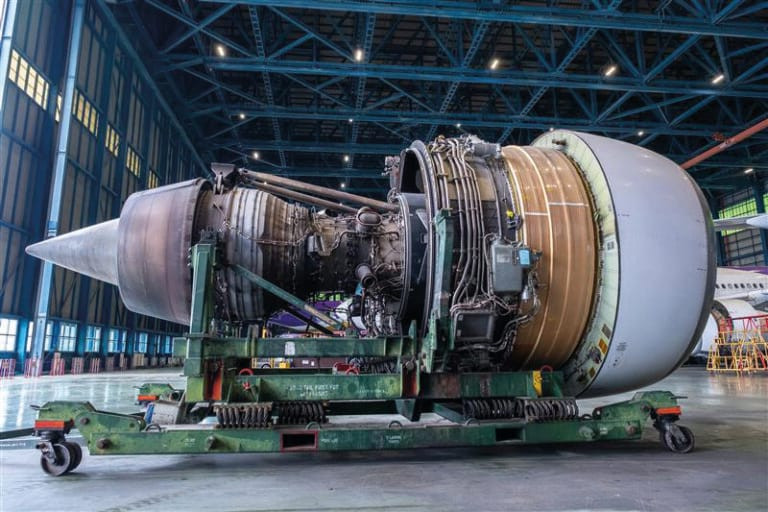- Aircraft engine logistics requires precision engineering, regulatory compliance, and careful risk management, with costs driven by airfreight, ground handling, insurance, and, critically, certified stand availability.
- Dedicated freighters, ULD-certified cradles, shock-dampening restraints, and temperature/vibration monitoring ensure safe transport, while specialised airports and trained staff provide the necessary infrastructure for intercontinental engine movements.
- Integrated services, including stand leasing, certification, customs handling, and door-to-door coordination, reduce delays, minimise risk, and maintain fleet readiness, safeguarding both operational efficiency and airline revenue.
Aircraft engine logistics is one of the most technically demanding and cost-sensitive areas in aviation supply chain management. What appears to be a simple shipping operation is, in reality, a process defined by regulatory compliance, risk mitigation, and engineering precision. A single misstep – whether due to the wrong equipment, improper documentation, or inadequate handling – can cost tens of thousands of dollars in delays, penalties, or damage.
Behind an engine shipment
Unlike conventional freight, an aircraft engine represents a multimillion-dollar, high-sensitivity asset. Depending on the type, an engine can weigh between 2 and 5.5 tons and reach 3 to 4 metres in length, containing hundreds of precision components designed to millimetric tolerances.
Each shipment must adhere to OEM Transport & Storage Manuals, EASA Part 145, IATA Dangerous Goods Regulations, and, in many cases, ITAR or export control requirements. Every stage – from preparation to delivery – must be executed under strict engineering and documentation procedures.
“An engine isn’t just a piece of freight,” explains Hanna Lavinskaja, Head of EngineStands.com. “It’s a core operational asset. If it’s damaged or delayed, the financial and operational impact extends far beyond logistics – it directly affects fleet availability and airline revenue.”
The true cost of engine transportation
The cost of moving an aircraft engine depends on multiple operational variables: engine type, mode of transport, distance, insurance, and stand availability.
• Airfreight: For a widebody engine such as the GEnx-1B, Trent 7000, or PW1100G-JM, typical air freight costs range from US$10,000-50,000, depending on routing and priority level.
• Ground handling and customs: Add another US$3,000–8,000 for documentation, permits, and specialized ground equipment.
• Insurance coverage: High-value cargo insurance typically adds 0.2-0.5 percent of declared value – for a US$10 million engine, that’s an additional US$20,000-50,000.
However, the most overlooked cost factor is stand availability. Without the proper certified stand, an engine cannot legally or safely move. Procuring or fabricating a compatible stand on short notice can take five to 14 days, during which storage, hangar, and missed-slot fees can accumulate at US$1,000–3,000 per day.
“Operators often underestimate the financial impact of stand unavailability,” Hanna Lavinskaja notes. “A single week of delay can cost as much as the entire air freight bill. That’s why proactive stand planning is critical to efficient engine logistics.”
Engine movement in the airfreight ecosystem
Approximately 70 percent of intercontinental engine transports occur via dedicated freighter aircraft, with Boeing 747-8F, 777F, and A330-200F fleets handling most widebody engines. Engines travel as special cargo, requiring:
• ULD-certified engine transport cradles (e.g., RR RB211, CFM56, LEAP-1A/B types)
• Shock-dampening restraints to prevent load shifts exceeding 0.3 G lateral acceleration
• Temperature and vibration monitoring systems to ensure compliance with OEM storage parameters
Airports such as Amsterdam (SPL), Frankfurt (FRA), Dubai (DXB), Singapore (SIN), and Miami (MIA) act as specialized hubs, offering heavy-lift equipment and trained ground staff. Most carriers allocate main-deck capacity only, as lower-deck transport is rarely feasible for engines exceeding 2.5 metres in height.
“Engine freight requires synchronized precision,” says Hanna Lavinskaja. “We coordinate not just with airlines, but also with airport authorities, customs, and insurers. A single procedural gap can stall a shipment worth millions.”
The core enabler of safe transportation
A certified engine stand is both a mechanical interface and a logistics instrument. It ensures the engine’s structure is supported according to OEM geometry, maintains clearance during movement, and integrates with air and ground transport systems.
Each stand model is type-specific, manufactured to OEM-approved drawings, and requires regular load-testing and recertification. For instance:
• A CFM56-7B stand weighs roughly 600 kilogrammes, supporting an engine of 2.4 tonnes.
• A Trent 1000 stand exceeds 1.4 tonnes, supporting an engine nearing 5 tonnes.
At EngineStands.com, every stand undergoes dimensional inspection, corrosion treatment, and functionality testing prior to deployment. The company’s global pool of certified stands supports more than 20 engine types and is strategically located near major MRO and airline hubs to ensure rapid availability. “We invest heavily in predictive maintenance and global stand positioning,” Hanna Lavinskaja adds. “Our goal is to reduce AOG downtime by ensuring that the right stand is always within reach – anywhere in the world.”
Integrated logistics and operational efficiency
EngineStands.com not only provides leasing solutions but also offers door-to-door logistics coordination, including:
• Stand preparation, inspection, and certification
• Export and customs documentation
• Multimodal transport booking (air, sea, or ground)
• Tracking, insurance, and delivery confirmation
By consolidating these steps, operators avoid managing multiple vendors and reduce total lead time by 20–30 percent compared to traditional sourcing models. “Every additional handoff adds risk,” Hanna Lavinskaja explains. “Our model minimises that – one partner, one chain of responsibility, full transparency.”
The economics of doing It right
Delays, re-handling, or damage can easily escalate logistics costs by 40–60 percent, while a grounded aircraft can cost an airline US$10,000–25,000 per hour in lost operational revenue. Ensuring stand availability, regulatory compliance, and expert handling directly safeguards the operator’s bottom line. EngineStands.com’s integrated logistics model helps reduce not only direct costs but also opportunity losses, enabling faster engine turnaround and maintaining fleet readiness.
Behind every engine shipment lies a data-driven chain of logistical control. From certified stands and weight-balanced cradles to customs documentation and multimodal routing, every variable contributes to performance and cost. The
aviation sector’s demand for uptime and compliance leaves no room for error. By combining engineering rigor with logistics expertise, EngineStands.com ensures that every engine moves – safely, efficiently, and economically – from one operation to
the next.





